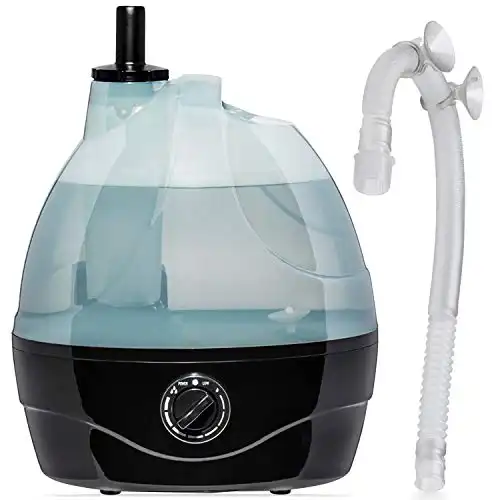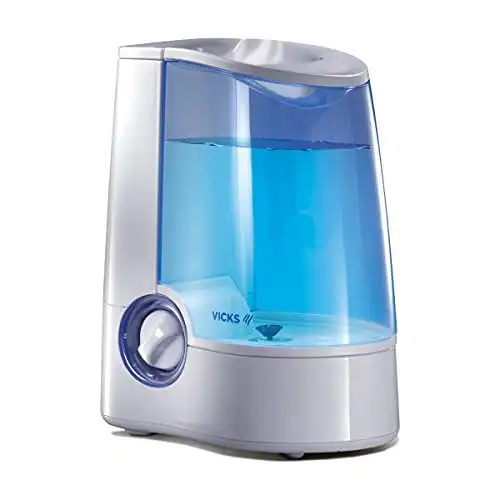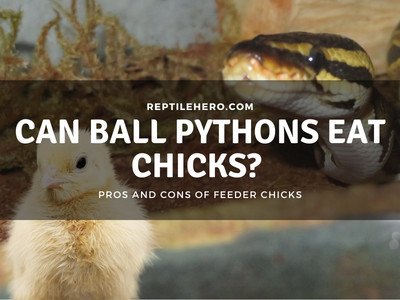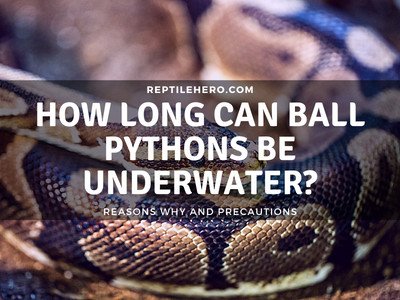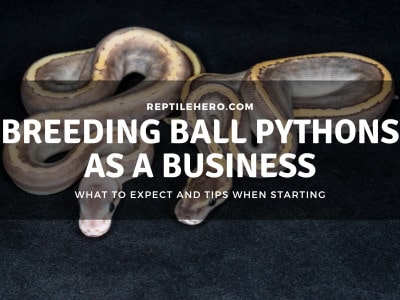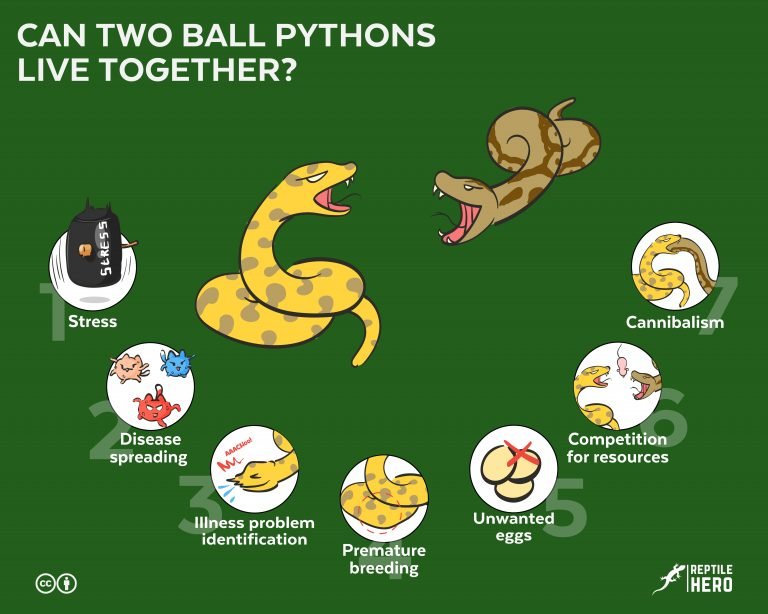Can You Use Foggers for Ball Pythons? (How About Misters?)
Foggers and misters look cool, but are they really safe for ball pythons? Can they solve humidity problems in your ball python enclosure? Or will they only give you that cool foggy effect?
In general, humidity devices like foggers, steam vaporizers, timed misters, and drippers can be used for a ball python. They are considered harmless overall but are prone to bacterial issues and produce too much humidity for a ball python.
Using automated humidity devices can make your life as a reptile keeper hassle-free. But are they reliable enough in the long run? What are other alternatives for increasing humidity in ball python tanks? Find out more as you read below!
Should You Use a Fogger for Your Ball Python?
In general, using humidity boosting devices like foggers and misters is not recommended for ball pythons. However, they can be utilized depending on the location the snakes are kept in captivity, especially when the climate is too dry.
As a rule of thumb, the humidity inside a ball python’s enclosure must not be lower than 55%. Humidity levels around 60-75% are recommendable [1]. You can check and monitor this using a hygrometer.
Ball pythons kept in enclosures with the right humidity levels, shed and eat better compared to those kept in an arid environment.
Illnesses like dysecdysis (abnormal shedding) and dehydration can happen due to a lack of humidity [2].
Conversely, too much humidity can cause microbial and respiratory infections in a ball python. Scale rot is the most prominent disease caused by bacterial build-up in a wet substrate [3].
Mouth rot is a common example of a respiratory infection that is caused by too much humidity combined with a low temperature.
What is the difference between a fogger and a mister?
The difference between a fogger from a mister is the size of water droplets they release. Foggers produce micro-droplet which lead to a foggy environment while misters deliver bigger droplets that emulate rain in the wild.
5 Factors You Should Try Out Before Using a Fogger
Most of the time, humidity problems for ball pythons can be solved without using a fogger or a mister. Some things to try or change are 1) new substrate, 2) lower ventilation, 3) larger water dish, 4) alternative heating and 5) enclosure material.
1. New Substrate
Using a substrate that can hold moisture better can improve the humidity of a ball python enclosure. Substrates that are excellent for moisture retention include coco fiber, coco peat, coconut husk, and cypress mulch.
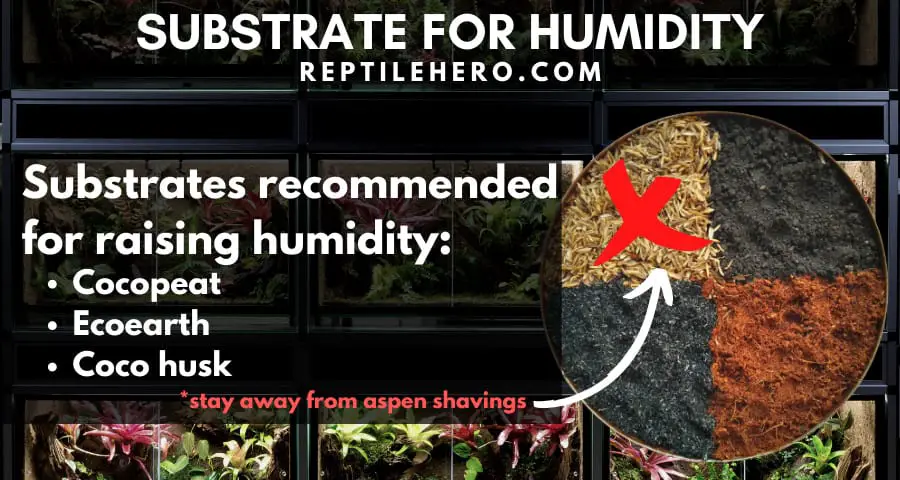
I recommend having a 3–4-inch deep substrate to retain more humidity. Mixing in dried moss and perlite can also help it retain humidity.
Beware, though, that these substrates, can be a breeding ground for bacteria and can cause scale rot to the underside of your ball python when kept too moist.
To know whether or not the substrate is too wet, squeeze it with your hands. There should be no water coming out of it.
If you are having trouble raising the humidity, stay away from absorbent beddings like aspen shavings. Personally, I use aspen shavings because it does not emit any bad smell and I live in a humid area.
Pro Tip: Mix and toss around your substrate from time to time. Doing this can help moisture last in your substrate and it can also prevent bacterial build-up.
>> Learn more about making a great substrate in our article about bioactive substrates.
2. Lower Ventilation
Too much ventilation can cause an enclosure to dry out quickly, as such lowering ventilation will raise humidity. For instance, screen or mesh lids can be covered with tape preferably HVAC foil tape. If there are ventilation holes a common tape can also be used.
When taping ventilations, I recommend leaving an open space for light fixtures to penetrate the enclosure. I also suggest that the tape should only be applied on the outside and not inside the enclosure.
Besides foil tape, a simple plyboard or plastic sheet can also work. Just check if it is flush to the screen top to block ventilation and allow a higher humidity.
3. Larger Water Dish
There are instances where a good-sized water dish can solve humidity or shedding problems for a ball python. The size of the water dish depends on the size of the snake. It must be large enough for a ball python to comfortably soak in.
If the humidity in your ball python’s enclosure keeps dropping, I recommend getting a larger water bowl. Personally, I use a large water dish made from plastic which allows Choco, my ball python, to soak whenever he wants.
As an alternative to expensive water dishes, you can use a large catch plate (typically used in gardening) with enough depth for your ball python to soak in. I have used a plastic one for 5 years which I got from our garden.

Because of this trusted water dish, Choco has not experienced a bad shed so far. I also see him soaking in it sometimes, especially when he is going to shed. The dimensions are 9 inches in diameter and 2 inches in height.
4. Heating Alternatives
High wattage heat lamps can lower humidity levels in ball python tanks quickly. For ball pythons, recommended heat sources include a low-wattage bulb, a deep heat projector (DHP), and an under-tank heater (UTH).
I recommend using low-wattage heat bulbs, preferably halogen, which are around 60W and can provide ample heating for an average ball python enclosure size of 40 gallons.
I also recommend DHPs instead of ceramic heat emitters for a night heating source. DHPs produce infrared light that penetrates deep into the ball python’s skin rather than just the surface of the skin.
A barrier should always be used and the recommended distance from the heater to the substrate is a minimum of 12 inches. Barriers prevent ball pythons from getting burned from contact with the DHP.
If your enclosure humidity keeps dropping down, a UTH can be used as they don’t lower humidity as fast as previously mentioned heat sources.
It can also provide more belly heat which is great for the digestion of food. Just bear in mind that this alone won’t produce sufficient heat.
One thing to keep in mind when using any reptile heating device is to keep them in a thermostat/ dimmer. Heating bulbs can overheat and a UTH can cause belly burns to a ball python.
>> Learn more about choosing the right lightbulb for your ball python in our article about can ball pythons see a red light
5. Enclosure Material
In general, PVC enclosures hold humidity better than glass ones. PVC enclosures typically have fewer ventilation holes and have a fully covered top. Nevertheless, PVC tank designs with screened ceilings are easy to cover up partially.
The cost, however, is the main problem with using this material. A good quality PVC enclosure is quite expensive, with prices ranging from 200-500 bucks.
I recommend this product from Zen Habitats which is a good quality PVC enclosure that includes a cover—humidity shield—that can drastically increase humidity levels in the enclosure. It can also be easily assembled with no screwing or nailing required!
Glass enclosures can still be used, but if the previous tips do not work, I recommend trying out PVC or plastic-type enclosures.
4 Automated Humidity Devices for Ball Pythons (Pros & Cons)
Although generally not recommended for ball pythons, automated humidity devices can be used if owners cannot effectively raise humidity levels using other methods. These devices are 1) foggers, 2) steam vaporizers, 3) timed misters, and 4) drippers.
1. Foggers
Fog humidifiers can improve an enclosure’s humidity as long as it is monitored or kept on a timer to avoid too much moisture. It is recommended to use a fogging system that lets off a cool fog to avoid causing burns to a ball python.
The benefits of foggers are: 1) humidity maintenance, 2) automation, and 3) DIY friendly.
Humidity maintenance is the main purpose of a fogger. Depending on the strength of a fogger, it will be easier to maintain a 60-80% humidity level by using this device.
Its automated feature also allows ease of access and hassle-free humidity maintenance.
For an adjustable fogger, I would recommend something that looks like as the one below. Just keep in mind that there is no timer yet for this fogger and only distilled water can be used to avoid malfunctions.
Can be made DIY using an ultra-sonic, cold fog humidifier and a plastic tube, you can make cheaper alternatives that can also work perfectly depending on the brand of humidifier you are going to use.
The risks of foggers are: 1) bacterial build-up, 2) malfunctions, and 3) excessive humidity.
Bacteria can build up on the main fogger itself and in the tubing used. Leaving a fogger unclean for a week will cause substantial bacteria build-up which can be harmful to a ball python [4].
Bacteria emitted by the dirty humidifier can cause mold and fungus to grow which can cause respiratory infections and scale rot.
Foggers malfunctioning is a common problem when using other kinds of waters other than distilled. Residues and minerals in most waters like tap and spring water can cause damage to the fogger’s system and can also promote bacterial growth.
Can cause too much humidity. Too much humidity is harmful to ball pythons when exposed to it in long term.
Constant high levels of humidity can cause bacteria build-up on the surface of the substrate which can cause scale rot to the underside of the snake.
2. Steam Vaporizers
Steam vaporizers produce a warm mist by boiling water inside a device. It is generally used in maintaining humidity inside a reptile room.
The difference between a reptile fogger to a steam vaporizer is its target and temperature. Foggers produce cold air by breaking down water droplets.
Steam vaporizers, on the other hand, boil water to create steam. This process will cause the room to be warmer and more humid.
One thing to remember is to make sure that the room humidifier you are going to use is an ultrasonic one. I recommend avoiding using steam humidifiers to have no risks of too much heat inside a room.
The benefits of steam vaporizers are: 1) humidity maintenance, 2) automated, and 3) prevention of bacterial growth.
Humidity maintenance. The steam produced by steam vaporizers is hotter and can provide good ambient humidity for a reptile room.
A good steam vaporizer like the one below can lift indoor humidity levels to around 60%. Just keep in mind to always use distilled water to prevent bacterial build-up.
It won’t be as effective as a direct fogger, but steam vaporizers can greatly help with humidity problems in your ball python enclosure, especially during dry seasons where ambient room humidity falls around 15-30% in some areas.
Automated feature. Steam vaporizers are very easy to use and can continue regulating the humidity throughout the day.
Preventing bacterial growth is a feature of a steam vaporizer. The heat from boiling water kills bacteria, especially when combined with distilled water.
Unlike foggers, steam vaporizers can be cleaned every 2-3 weeks depending on how often you use them. You can clean it by simply washing it with dish soap and water.
The risks of steam vaporizers are: 1) too much heat and 2) very low humidity.
Too much heat can cause health issues like burns and overheating. Although this is a rare occurrence, I suggest putting the steam vaporizer away from your ball python or any enclosure.
Insufficient humidity. There are times when a steam vaporizer won’t cut it in maintaining the humidity of an enclosure.
Ambient room humidity can improve an enclosure’s moisture levels, but sometimes the heat coming from a light source in the enclosure can prevent the ambient humidity to affect the enclosure.
>> Learn more about the effects of low humidity in our article about ball python dehydration
3) Timed Misters
In general, misters produce water droplets through a nozzle either on a device or a spray bottle. An automated mister is not recommended for ball pythons because it can soak the substrate too much which can cause infections and diseases.
Instead of using an automated mister, a spray/mister bottle can be utilized to spray your ball python’s enclosure when they are going to shed or if the humidity is significantly dropping.
The benefits of timed misters are: 1) fast spikes in humidity and 2) automated.
Fast spikes of humidity are the effect of using misters. I recommend using timed misters during the shedding period of a ball python.
Keep in mind that aspen beddings can cause fast bacterial build-up when damp so do not mist an enclosure with this type of substrate.
Automated misters can be timed to make sure that there is just enough humidity in the enclosure. I recommend timing it to spray every 12 hours at around 15-20 seconds of spraying.
The risks of timed misters are: 1) can soak the substrate and 2) bacterial build-up.
Soaked substrates are one of the most common causes of scale rot in ball pythons. Using a timed mister can increase this risk since most of these devices spray water in large amounts.
Bacteria can build up easily in the main mister and the enclosure itself. Regular cleaning is required especially when the water is often stagnant inside the mister reservoir.
4) Drippers
Drippers are an inexpensive alternative to misters that can be made using simple tools found at home. They are recommended to be used above a water dish or plants to avoid getting the substrate too soaked.
The benefits of drippers are: 1) humidity maintenance and 2) inexpensive.
Maintaining humidity through a homemade dripper can work especially if positioned above a plant or a water dish.
Inexpensive. You do not need to buy anything to make a dripper. You just need a bottle with a cap, a pin, and distilled water.
The risks of drippers are: 1) can soak the substrate and 2) securing issues.
Soaked substrate. If positioned inaccurately, a continuous drip of water can penetrate deep down the substrate which can cause mold and bacterial build-up.
Securing the device. If the dripper is placed inside an enclosure, there is a risk of it falling and possibly hurting the snake. A ball python can also climb up to it causing it to collapse and can lead to injuries.
3 Alternatives to Provide More Humidity to a Ball Python
Other inexpensive alternatives to make a ball python enclosure more humid are 1) humidity box, 2) heat over water, and 3) moss bags.
1) Humidity Box
Making a humidity box is highly recommended, especially if a ball python is going into shed. It can be composed of damp moss, coco husk, or paper towels.
It is recommended to have only one hole for the humidity box for the ball python to come in. No other ventilation holes are required to be able to trap humidity inside the box.
When left uncleaned for prolonged periods, it can be a breeding ground for bacteria harmful to your snake so I recommend replacing the beddings at least once a week or when your ball python defecated on it.
I also recommend using distilled water in moistening the substrate inside it to lessen the risk of bacterial build-up.
2) Heat Over Water
Another way to increase humidity in a ball python enclosure is to put a heat source above the water bowl. This will allow the water in it to evaporate and turn into a vapor which helps in maintaining the proper moisture.
It is recommended to regularly fill up the water dish used for humidity to avoid it drying out.
You can also use another water bowl so that the ball python can choose whether to go soak in the warm or cold water.
3) Moss Bags
On average, moss can soak up to 30% of its weight. So if a moss bag is made, the amount of water absorbed will increase drastically, making it ideal for providing humidity for ball pythons.
Moss that is formed into a ball is covered using stocking or a fine net. It is also recommended to add water over time to avoid it drying out.
Another way to increase the humidity is by putting the moss bags below the heat source. This will allow the water to evaporate and increase the moisture in the air.
However, I discourage using damp towels and wood because they are common materials that provide a place for bacteria and mold to grow.
Further Questions
What is the best way to add humidity to a ball python tank?
The best way to add humidity is to put an appropriately sized water bowl inside a ball python’s enclosure. The size should be enough to allow the snake to soak and shallow enough to prevent drowning.
How much water should be sprayed on the ball python?
Misting a ball python’s enclosure for 10 seconds twice a day can help the snake in shedding. Mixing the substrate after a mist is also recommended to prevent the stagnant build-up of water in it.
When is the best time to spray water on a ball python?
The best time a ball python should be directly misted is when they are outside their hide which is typically at night time. But their enclosure can be misted even if they are hiding so that the proper humidity levels can be attained.
Do ball pythons like being sprayed with water?
There are no psychological studies to confirm that ball pythons like being sprayed with water. However, they can be sometimes seen soaking in their water bowls, meaning there are times when they seek water whether to excrete waste or to prepare for shedding.
Do snakes need misters?
Most snakes do not need misters when kept in captivity except for a few species. One example is the dragon snake, which is a peculiar and rare species of snake that thrive in a more humid environment and are only kept by advanced keepers.
Are fog machines safe for snakes?
Fog machines can be safe as long as it uses water with no harmful chemicals and is controlled by a thermostat to prevent too much humidity which can be harmful to some snakes.
Summary of Can Foggers be Used for Ball Pythons
Most of the time, humidity problems for ball pythons can be solved without using a fogger or a mister. Some things to try are a different substrate, lower ventilation, larger water dish, lightless heating, and different enclosure material.
Although not recommended for ball pythons, automated humidity devices can be used if there are still low humidity problems. The devices are foggers, steam vaporizers, timed misters, and drippers.
Other inexpensive ways to make a ball python enclosure more humid are the usage of a humidity box, heat over water, and moss bags.
Resources
[2] https://www.msdvetmanual.com/all-other-pets/reptiles/disorders-and-diseases-of-reptiles

